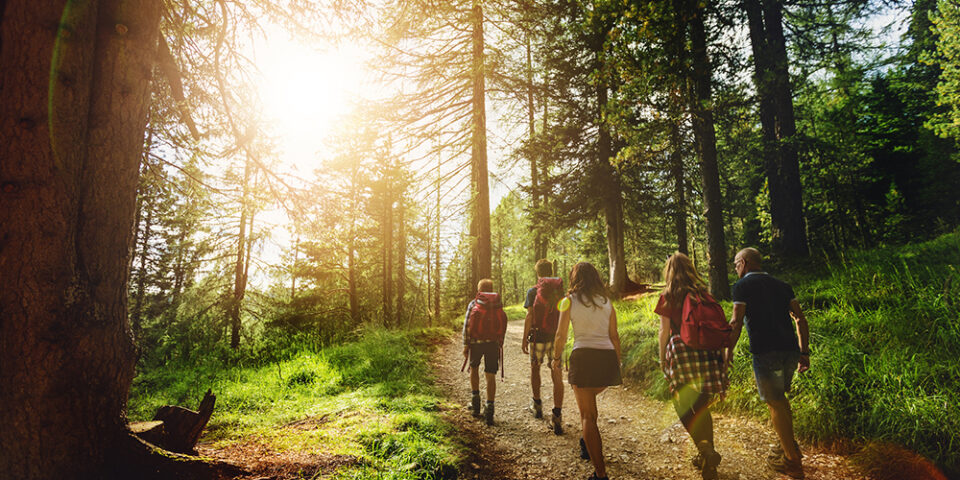Tips for staying safe while hiking
Whether it’s a day hike through the woods or a long-distance adventure, any outdoor activity requires some preparation. Emergency medicine physician Nathaniel Mann, MD, explained what you need to know to stay safe and comfortable while you spend time enjoying the great outdoors.
What are the most essential items to bring on a hike?
Dr. Mann said it’s important to bring the “10 essentials,” which are important to help you stay safe while hiking, as they cover most of your basic needs for survival. They include the following:
- Navigation. Bring devices that help you know where you are and where you’re going such as a compass, map, GPS device, personal locator beacon or satellite phone.
- Light. A headlamp or flashlight and extra batteries is important.
- First aid kit. Be sure to include items specific to your activity.
- Sun protection. Include sunglasses, sun protective clothing and sunscreen.
- A knife. This can be extremely useful in an emergency situation.
- Tools to make a fire.
- Shelter.
- Food.
- Extra water. If you’re in an area where there’s a lot of water available, you can just take a water purifier or some way to boil it.
- Appropriate clothing. Be prepared for inclement weather.
What clothing and accessories are most helpful for staying safe while hiking?
Having the right footwear is critical.
“Not breaking in their hiking boots is one of the biggest problems that people run into,” Dr. Mann said. “A lot of people think that breaking in boots means you must wear them down and get them softened up. But some of it is allowing your feet to get used to wearing that footwear.”
Regular tennis shoes and everyday clothes like cotton T-shirts and shorts are fine for very short outings, but if you’re going on a more serious hike, it’s best to have the right shoes and think about your clothing a little more closely. For instance, dress in layers.
“People don’t often realize the trouble you can get into when you’re sweaty and then get cold,” Dr. Mann said. “You can develop hypothermia. It’s also important to wear clothing that can allow you to offload heat in warm environments. People often underestimate the cold or think they’re stronger than they are, and staying safe while hiking is much harder if you’re not dressed for the weather and terrain.”
An extra pair of dry socks and underwear, as well as a rain jacket, can make a big difference in keeping you comfortable.
What items should be included in a first aid kit if you’re hiking?
Dr. Mann said it depends on the activity, your physical and medical conditions, and who you’re hiking with.
“For most of my trips, I usually take a small first aid kit that includes some sort of mild painkiller, like ibuprofen or Tylenol,” he said. “And then it includes items I can’t replicate well from the environment around me. Things like tape can help close wounds or repair things that get damaged. Sometimes I’ll bring an anti-nausea pill. An EpiPen can be very important, especially if you are in a group and someone discovers they have a severe allergy. There’s nothing you can do for that person if you don’t have the right medication. So, I usually recommend that people carry an auto-injector epinephrine delivery device.”
What should you keep in mind if you’re hiking with a group versus hiking alone?
Being aware of the physical limitations or medical conditions of the people in your group is most important, Dr. Mann said.
“Groups sometimes can be an increased safety factor. Having additional people who can pursue help or assist someone who is injured is important. But it can also increase the danger dynamic if you have somebody who is hesitant about saying they have a particular illness or physical limitation and feel a little bit of peer pressure to go along. So, it’s important to speak to everybody in the group to know their limitations and what are they comfortable with.”
What else should you keep in mind for a successful hike?
People often get into trouble because they’re unfamiliar with the terrain or the route. Maybe it’s steeper or more slippery than you anticipated, or maybe you take a wrong turn and get lost.
“A lot of times when you get out into the woods, things don’t always look the way you anticipated,” Dr. Mann said. “At a minimum you should have a map or a tracking device or a compass and know how to use it well so you can use the tools you’ve brought.”
Also, don’t rely on your cell phone because cell service can be spotty or non-existent. If you can, bring a GPS unit or a satellite phone.
“One of the most important rules for staying safe while hiking? Make sure someone else knows where you’re going and when you plan to be back,” Dr. Mann said. “There’s usually some sort of trail registration for a lot of the major traffic trails and riverways. Fill out the registration card so that people know you’re out there.”
Find the care you need, close to home
Our primary care physicians provide well visits and everyday care when you need it with compassion and expertise.
Find Primary Care Near You

